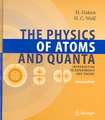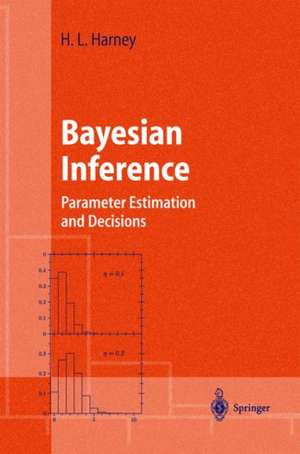Bayesian Inference: Parameter Estimation and Decisions: Advanced Texts in Physics
Autor Hanns L. Harneyen Limba Engleză Hardback – 19 mai 2003
Din seria Advanced Texts in Physics
- 15%
 Preț: 590.30 lei
Preț: 590.30 lei -
 Preț: 480.01 lei
Preț: 480.01 lei -
 Preț: 202.50 lei
Preț: 202.50 lei - 15%
 Preț: 475.62 lei
Preț: 475.62 lei - 15%
 Preț: 710.75 lei
Preț: 710.75 lei - 15%
 Preț: 468.57 lei
Preț: 468.57 lei -
 Preț: 393.35 lei
Preț: 393.35 lei - 15%
 Preț: 571.96 lei
Preț: 571.96 lei -
 Preț: 395.47 lei
Preț: 395.47 lei -
 Preț: 403.75 lei
Preț: 403.75 lei - 15%
 Preț: 542.04 lei
Preț: 542.04 lei - 18%
 Preț: 792.96 lei
Preț: 792.96 lei - 15%
 Preț: 658.70 lei
Preț: 658.70 lei - 18%
 Preț: 729.68 lei
Preț: 729.68 lei - 18%
 Preț: 720.53 lei
Preț: 720.53 lei - 18%
 Preț: 975.10 lei
Preț: 975.10 lei -
 Preț: 412.78 lei
Preț: 412.78 lei - 15%
 Preț: 713.69 lei
Preț: 713.69 lei - 15%
 Preț: 588.50 lei
Preț: 588.50 lei -
 Preț: 402.76 lei
Preț: 402.76 lei - 18%
 Preț: 739.81 lei
Preț: 739.81 lei - 15%
 Preț: 651.84 lei
Preț: 651.84 lei - 15%
 Preț: 646.11 lei
Preț: 646.11 lei - 15%
 Preț: 653.14 lei
Preț: 653.14 lei - 23%
 Preț: 676.66 lei
Preț: 676.66 lei -
 Preț: 413.15 lei
Preț: 413.15 lei - 18%
 Preț: 730.79 lei
Preț: 730.79 lei - 15%
 Preț: 644.30 lei
Preț: 644.30 lei - 15%
 Preț: 543.34 lei
Preț: 543.34 lei - 15%
 Preț: 652.17 lei
Preț: 652.17 lei -
 Preț: 388.52 lei
Preț: 388.52 lei - 15%
 Preț: 605.20 lei
Preț: 605.20 lei - 18%
 Preț: 798.50 lei
Preț: 798.50 lei - 18%
 Preț: 1852.57 lei
Preț: 1852.57 lei - 18%
 Preț: 947.85 lei
Preț: 947.85 lei - 18%
 Preț: 969.44 lei
Preț: 969.44 lei
Preț: 462.69 lei
Preț vechi: 594.31 lei
-17% Nou
Puncte Express: 694
Preț estimativ în valută:
88.54€ • 91.88$ • 74.01£
88.54€ • 91.88$ • 74.01£
Carte indisponibilă temporar
Doresc să fiu notificat când acest titlu va fi disponibil:
Se trimite...
Preluare comenzi: 021 569.72.76
Specificații
ISBN-13: 9783540003977
ISBN-10: 3540003975
Pagini: 263
Ilustrații: 55 Abbildungen
Dimensiuni: 155 x 235 x 24 mm
Greutate: 0.64 kg
Ediția:2003
Editura: Springer
Colecția Springer
Seria Advanced Texts in Physics
Locul publicării:Berlin, Heidelberg, Germany
ISBN-10: 3540003975
Pagini: 263
Ilustrații: 55 Abbildungen
Dimensiuni: 155 x 235 x 24 mm
Greutate: 0.64 kg
Ediția:2003
Editura: Springer
Colecția Springer
Seria Advanced Texts in Physics
Locul publicării:Berlin, Heidelberg, Germany
Public țintă
GraduateDescriere
Filling a longstanding need in the physical sciences, Bayesian Inference offers the first basic introduction for advanced undergraduates and graduates in the physical sciences. This text and reference generalizes Gaussian error intervals to situations in which the data follow distributions other than Gaussian. This usually occurs in frontier science because the observed parameter is barely above the background or the histogram of multiparametric data contains many empty bins. In this case, the determination of the validity of a theory cannot be based on the chi-squared-criterion. In addition to the solutions of practical problems, this approach provides an epistemic insight: the logic of quantum mechanics is obtained as the logic of unbiased inference from counting data. Requiring no knowledge of quantum mechanics, the text is written on introductory level, with many examples and exercises, for physicists planning to, or working in, fields such as medical physics, nuclear physics, quantum mechanics, and chaos.
Cuprins
1 Knowledge and Logic.- 2 Bayes’ Theorem.- 3 Probable and Improbable Data.- 4 Description of Distributions I: Real x.- 5 Description of Distributions II: Natural x.- 6 Form Invariance I: Real x.- 7 Examples of Invariant Measures.- 8 A Linear Representation of Form Invariance.- 9 Beyond Form Invariance: The Geometric Prior.- 10 Inferring the Mean or Standard Deviation.- 11 Form Invariance II: Natural x.- 12 Independence of Parameters.- 13 The Art of Fitting I: Real x.- 14 Judging a Fit I: Real x.- 15 The Art of Fitting II: Natural x.- 16 Judging a Fit II: Natural x.- 17 Summary.- A Problems and Solutions.- A.1 Knowledge and Logic.- A.2 Bayes’ Theorem.- A.3 Probable and Improbable Data.- A.7 Examples of Invariant Measures.- A.8 A Linear Representation of Form Invariance.- A.9 Beyond Form Invariance: The Geometric Prior.- A.10 Inferring the Mean or Standard Deviation.- A.12 Independence of Parameters.- B.1 The Correlation Matrix.- B.2 Calculation of a Jacobian.- B.4 The Beta Function.- C.1 The Multinomial Theorem.- D Form Invariance I: Probability Densities.- D.1 The Invariant Measure of a Group.- E Beyond Form Invariance: The Geometric Prior.- E.1 The Definition of the Fisher Matrix.- E.2 Evaluation of a Determinant.- E.3 Evaluation of a Fisher Matrix.- E.4 The Fisher Matrix of the Multinomial Model.- F Inferring the Mean or Standard Deviation.- G.1 Destruction and Creation Operators.- G.2 Unitary Operators.- G.3 The Probability Amplitude of the Histogram.- G.4 Form Invariance of the Histogram.- G.5 Quasi-Events in the Histogram.- G.6 Form Invariance of the Binomial Model.- G.7 Conservation of the Number of Events.- G.8 Normalising the Posterior of the Binomial Model.- G.9 Lack of Form Invariance of the Multinomial Model.- H Independence of Parameters.- H.1 On the Measure of a Factorising Group.- H.2 Marginal Distribution of the Posterior of the Multinomial Model.- H.3 A Minor Posterior of the Multinomial Model.- I.1 A Factorising Gaussian Model.- I.2 A Basis for Fourier Expansions.- J.2 The Deviation Between Two Distributions.- References.
Recenzii
From the reviews:
"The book under review combines features of a textbook and a monograph. … Arguments are presented as explicitly as possible with the aid of appendices … . There are numerous examples and illustrations, often taken from physics research. Problems are posed and their solutions are provided." (Joseph Melamed, Zentralblatt MATH, Vol. 1019, 2003)
"The book under review combines features of a textbook and a monograph. … Arguments are presented as explicitly as possible with the aid of appendices … . There are numerous examples and illustrations, often taken from physics research. Problems are posed and their solutions are provided." (Joseph Melamed, Zentralblatt MATH, Vol. 1019, 2003)
Textul de pe ultima copertă
The book provides a generalization of Gaussian error intervals to
situations where the data follow non-Gaussian distributions. This
usually occurs in frontier science, where the observed parameter is
just above background or the histogram of multiparametric data
contains empty bins. Then the validity of a theory
cannot be decided by the chi-squared-criterion, but this long-standing
problem is solved here. The book is based on Bayes' theorem, symmetry and
differential geometry. In addition to solutions of practical problems, the text
provides an epistemic insight: The logic of quantum mechanics is
obtained as the logic of unbiased inference from counting data.
However, no knowledge of quantum mechanics is required. The text,
examples and exercises are written at an introductory level.
situations where the data follow non-Gaussian distributions. This
usually occurs in frontier science, where the observed parameter is
just above background or the histogram of multiparametric data
contains empty bins. Then the validity of a theory
cannot be decided by the chi-squared-criterion, but this long-standing
problem is solved here. The book is based on Bayes' theorem, symmetry and
differential geometry. In addition to solutions of practical problems, the text
provides an epistemic insight: The logic of quantum mechanics is
obtained as the logic of unbiased inference from counting data.
However, no knowledge of quantum mechanics is required. The text,
examples and exercises are written at an introductory level.
Caracteristici
Brings a basic introduction for advanced undergraduates and graduates
With applications to physics
Works also w/o thorough knowledge of quantum mechanics
With applications to physics
Works also w/o thorough knowledge of quantum mechanics
